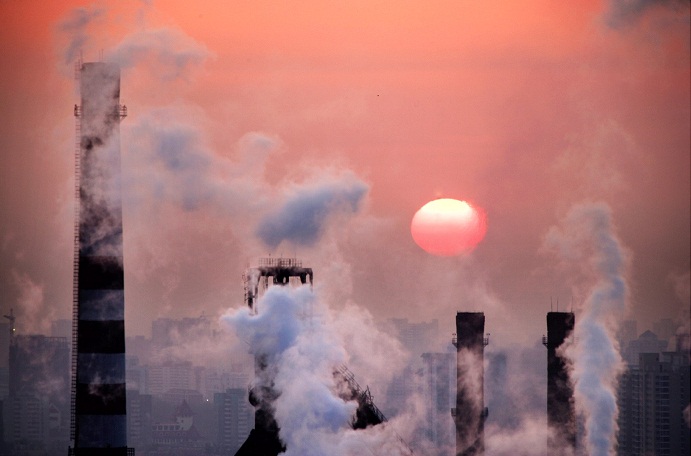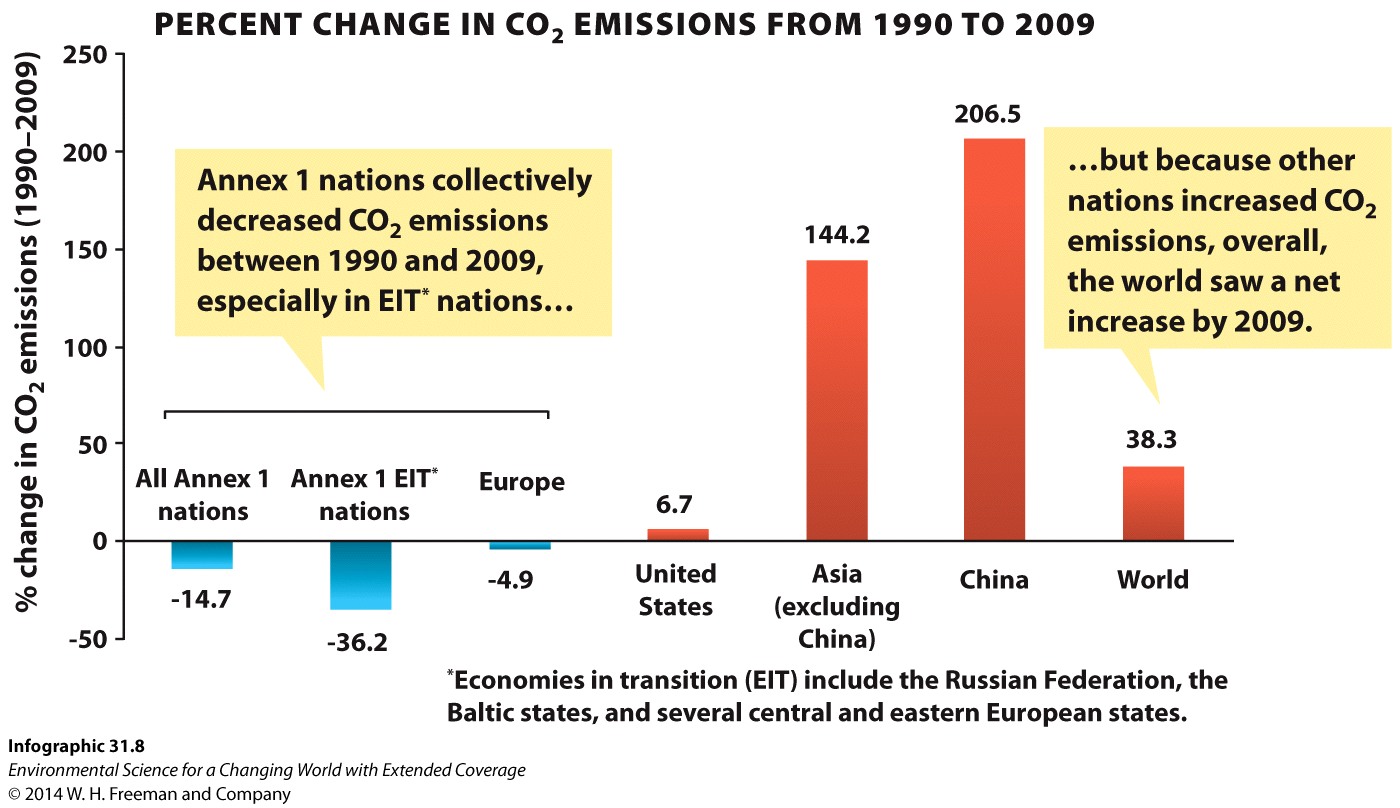Chapter 31. Chapter 31: Environmental Policy
What international policies have been established to deal with climate change and where do we currently stand on this issue?

Guiding Question 31.5
What international policies have been established to deal with climate change and where do we currently stand on this issue?
Why You Should Care
Climate change has been recognized as an international issue since the late 1970s, but it wasn’t until the 1990s that global consensus agreed that humans were releasing levels of greenhouse gases that were causing the climate to shift. Once the problem was identified, the next step was to set policy to limit release of those gases. The first attempt to set up a framework policy was the Kyoto Protocol, which set reduction goals for developed but not developing countries, beginning in 2005. The rationale was that developed countries had not only higher per capita emissions, but also the budget to fund incentive programs to minimize release. Developing countries had lower per capita emissions but even for the higher emitting developing countries, they didn’t have the budget to fund programs to lower emissions.
This impasse lasted until 2003, when the Clean Development Mechanism set up policies to shift money from developed countries to developing countries. The mechanism has a clever core: Developed countries need to lower emissions, but if they are still over their national goal, they can purchase credits from developing countries that are below their national goals. The profits from the purchase would be spent to transition away from emission-producing toward renewable or more efficient programs.
Since 2005, there have been a number of improvements and clarifications of the goal of limiting warming to 2°C, regardless of the gas emissions it will take to keep warming below that level. Most recently, the meetings have set out the goal of the next level of emission limitations that will replace Kyoto’s goals. These new targets will be negotiated by 2015 and will start in 2020.
The slow, back-and-forth pattern here shows us the nature of international negotiation and policy. It has taken decades but at the end of it, the majority of world is working towards goals and is bound by specific programs and policies that support that goal.
Question Test Your Vocabulary
Choose the correct term for each of the following definitions:
| Term | Definition |
|---|---|
| 1kXNF3jZJUypqUePk/UZmcKHUmShMFuEgBfaJ7Pfa2OX6bs73BSRQM0G/2BHnPyKxOycGX8rD4D2RO6uvbrXToZnC/8RGzfC84x246fHniCTT6tONIR0uMLjAhuHc7O/ZkXBDS4U66KDA5TX | A 1997 amendment to the UNFCCC that set legally binding specific goals for greenhouse gas emission reductions for certain nations that ratified the treaty. |
| GFNPpjHTKj6EP0k651QHyTSlotUzBCX/yD+gtcMYJoq1QbjCjvbDYCk9lVcmj4cdtjqOys/Zfdd3PWb0JTHiBDUT7Ewp7EQEnsdTQZfEs4CxiptktjtPgBsdKRRsg3Yat8aPwKD0WpEEUpn8 | An U.N. program that allows a country with a GHG reduction commitment to implement emission reduction projects in developing countries. |
| dyVyAfTBurjuc4qKS2KndMWSSoFG/NhXHuerHARaLm8ajKolAXuanebFxG4MLrGOkCXLYSkGbNUnqPB+vlqZDz3aCGqSqHBP14DsMIwrsH34HGwFQ9nP6h5GC/qfCS1BQ6xlc/0si/q3BSBX | A target of the mini¬mum fuel efficiency (MPH) that manufacturers must meet; evaluated as a weighted average of all the cars and light trucks each manufacturer produces. |

Question 31.1
5UIvIvRbXOgIB9c0ehKhwIsINFeuMEcFU18QJW+QAvmgddrVGIL+gs1JEVjP3nZrihCSy6yAAiSvaddIDVxwCiO7S9DnDh8jcT5dgpYTmRf6ICv+NWzs2LsLwHraOxHLVXk7A5Bj3QOMfWY+CX81PT9ZBujM3Jzk4jgAmceyYy2oM5wb/zx8YOSm2c5Pxe417CA7EaVYv9CKIr/9a+2y9SsgUuLHuJ1xNPqZIt/BSLDx/gqXjfRCziaflAjQcl6RS1SECkXvZKk=Question 31.2
FHWuKjP+WEVdoHO8rQAx6CwNAuSO3xWwcO4bSN274tf7VftIxo7SkKWT+H76C86j3mHRIEWamcMcUT3x0nZ5Fwo1pCSXDkUtO3aaOMufsRfbRPkBeeLFGokXJ44xOCEZ0wv9KrmYox++YwpeD/4EGreI4FVBn5cqQ8MVJNMofd3mBjNrQuestion 31.3
KG87eaWNKwVYmpM/1UbuXcTFxob8QDlHP7rPMc8WrSpLWFrRlIHNy2GT6cziWqMJHl6vct5Ej3y5asdjnCqiHYvz/c2cDc1sWRI+PGNQS+YX269CB3HyKVwgYhFW/SiTzeXCA4Z1y5PADjEpOiDflYHHS4NGkEwL8GchJQwor0+4Waq20KMGivPeSldtb7T8SUqppTQV6PS0QVT+usDvhRyWRu/hKnYyGf6xedS7Tgd4AZZbzhZzHTDbDsL9Kjrb7Iu0cg9jx17TyqlBkGV8v9zy6l57fiyeQuestion 31.4
zzfZk1r+L917nMONPvTAIzmh+1xc5jKlsykDYhlK6ARyMqh4jBX4tgfPkdzxM1XaJ6mEoeRYyY4K4Aing6I10Z3q/z/MiXiwCgUSs7KiIfvtGueROGSZLibQ5U/c0Tjw13AA6mtSq0Qvk8m6hKnKNdoz/HglYXaSxQJkUs3X+AJiz1BUP/f2xklo6LvhuuSQeASaSBAAItYqLOgMgAfc3lthdlQN4//tVVDh/CfbbafB7P8owOnmj7gkAgg=Question 31.5
8SS+EjLAjXCSKy0FaMH+oU8MjXjHE045CMTXk0NjFkiNsYfh1wi4LdCVfZQeUmK5JrXWmhqcb/PfY+Qy02xQKpUCZlkegy9uV1vDJ+A5gfGrTmCRUQqYuzTWboIJRgXiry+YJT7cp67Ixy6AQW/tx5JiiuOWNKNEWDfoT6JA0QDaBnRSxJB+r76/0Vyw4iMoR8BmYL6mzTd5ThLAKrLqBo9xiJTAK7gVqxlZ9PNEUn+qKlsS0M2D0seFWM28tv+qBdX+tuJgJ1rR2GMBLw66YAIBpkmTHbzEBjVIxTJtzpUbvqjLOdvj/enm6sEloq81albWjCno5Xnl2YU72ZrF9mcAA3IV9qGCJiODplEsrN1il305PqPttstVo2MFzvrEAG1mArMMPwARYYVz2QS3/HwgWZ45oqlE57wJMLeLXUqpvMzLKvDHeIgWsamGNtEalvc91ICr00wDkF4Nvs1TT85Hyf67rdhd0WlGJI95TFuqcO0zy6gbwAZV1Idssj2HTzEBA0QykVaEM7GvqS9EdspGu4xg5X83k2hiBA==
Question 31.6
4BaWaReWjHbAX1EsSH2xixtf+iQGaA51pPs1ue6CQiCxSRbDegJRjcxGeQkmNgpvClnEz5hzF5AHaVkc0fSMILOP8/HMw2I/BivPAzfZ94SbwJ+yvwzx0nF2T5F1SNRdrfsBQ/wh9cpBgjZgETrTqIPW+h0dmbUYLRWpaH7ZWBiftVXe/OdyutzPnOVLxzDyPRJxp5CRZyop0mg3hHxFgQd2bxDuYVefY/Xstrrd65aRKbhAi7MJbSeBQGGxV3rDGmSdT4u/i7WUgh2LQuestion 31.7
rEcjlzWPec/MxaRv86mNBFRyTtbA97QD0PMksjw8Yr0EbOAygg+SRkwjFaMlLeg8KIWzTBEk6M/iWZOHYLOQmqrqp5slTjD8fyw51kKdq5YuCfqx5OMissPcBrygrIdk+YuR1vfJbt3zEpo2hU9foHjvLduDjz+oa1VaK1hfXzKMeNMUM/I4KrQ5miBbCWA5vLpvuTWwkMAA3zaH18qzq3Jo370uxtzYgf2Hw9M3tTGWtnVQaakM5VitaSAPIMFixo5VY8wBJxo=Question 31.8
HxVDW569g3pfv8+U4AnBIZORTLrG9DqkrAgzbN+vP4dwVs/nEaGRHu5xjkgR9RxWLFLOynptAi2zDWlIVP3QrI7iLDfhe3h6HplRuyS0XDOZD/cvtrEDBkAcJaFvZhpraOjBv6FUY4moVvMek1OF+CaJvZI9wqH9zKRBJY8Y+q0TEmFzyt9Narwy/9NsOTM9KzWNeSoId+z1+m7Dji/Kec5ZQVaMdodklnGDMH29SKFR4bF4o04LbUzkEbgZ60MjD2QsCJr/HBJbp9YNromuDLy/e8EI4crdRnRmXNr7IHy4eFsKUZntAQ2hMBP3lQUMsKcwMUnTeeXDdrAYNQBirVDP3c/6+ztAZIbCbKwNIOPQDni3vX0I2DV0O4f1V6lolDncUaK0grbpJW7GDP+BB9JXpkpXJZRPffM8HAGHVgIzaGZrv+Hr9Xauqz6a/0vw/0wvLsTYtk6PxyVKhda8eTeBVzp2Bnxlzh26c3mxsXBCqUxVduYKvICldo93ZWDejbZiaC7bBCx1xwmoHeK4led5tEddrBKngoP6zCEw+j0u9gj6ujeQEdYc8HNiHydJZIOZhA==Question 31.9
HQJiiBZ1e29gWZv//lBsKavKOCMr/qMUW7pziWU4HS0LDeZJDpNs9cneXdgVeJhvxyEod5Xt95U9Z8YEulPKG0sixj4bay3vtpHJ3KHmRX6Q5xziYWrMJM8gMz8LPYFxvHg9GRE50cKwHgLxx2Pv+hkkDvxLX2wOB55P3Aw5vR7obdZFebw6d6sCLhaQA6CUrGu0B4nLmj++17cCaaliqb6o0aW0WwMxjNY68qlH1/TwOeGvCMkJ5xgAhgvKo/E/2vr/qyKn0vaEZKor5ayjImSD3DSqJaNeT6CHfXePhA/6R6XpQuestion 31.10
Lm4/ohaoRhu3usGra4bjVumKJZA5DFAJHGiuBHpkfxEUyC13V+4Do9WW5IRKm9QQXjDN2HOkNlsvHO7hImv9P811RqSgZXCt5XOaSjKne/6A45MPJmKGYbzRiidY3tlmlCFig4QS9wLOrviRWseS0Gh//KlCIn25OvB89ZuXmI4b45vBUz74hh+lE6OE72J64YeKcAcqNAMEIrDCSnuhKyr+uuVTV3aX1wGMl5+h5JklwY7QucWMIQ8DqxJ2A+OfVqt0ITuWQEQo3OweviBh8ib77g77WhEp9hrVJvObfuuHLECqmMaUhBxZ2W8kbVa14T5faLqtmy3tCYJdeuxMSc1hvZ7sJivQi3cZ4f2Krcxt/6Klgnk8/H29ydl5MFnspdQH+5VYDHpwTlpnBlnMS6XyBJqTK4sMD/+EVA==Question 31.11
fTTthFTmggUDKTv19KQ+Zfo7jWxNXDV1BngAVW0Xelnb9PoMpntEeO52JlYv64RwAtW2PLKMu/ymjgGHmq8xyUEI7gRewcbecWc5Hfwe0uTYjBGldxMQGNbMcdHPBmRTjiMZl90ROJfe+clQerKPAYZWaB0NJXFCDoU4mv3b98DVyuxmPv7QgD4IyMTY6u02AfgUvujx3pAW3EXWg1tPb11pByDLIBzG0mC5n3N2k0PJExwTvvIMXZbhX/Mb1ysLO92RZwgQEFT3kLsIWUxEvXgsJJXA5iNRsoRyGqv6c+fiOdazXp19p1U7+9/WfrVq/ZXjoQm7cwmmwTX1sjwNaaDJGvIuRJ6Mq5CPMksfbr5e+bJI0Zn2EL2v0D/ZNe9X0tjtnUnhOHzkcqhotchr2aa4FPyy1TpZi1zZZ/YTL+1VH2lNz68XoHmVZIUE8G3qPCdGXoEM25YAeXYShWdiUGxi+YWRPdJYwwyvHKY9ae+qbBYcIN3Eu4K9D118U4qmaI9rGJT3JdNum283heBA0HrWRwtLf9MC9HGmaN46UWCeENaFYkdANuB/E8Y8ilm3/YbacBxwBT6d78YSQaoUNLxPhWXOami5fLCS6s/XKRt7fkwFcQYAsZm3eviUUEtFJgBSxdPKwJabjf5ARxIYE/F30mCAmGM9lJXpWBb+Xhzy1jDiFk/pPQV+fxI=Question 31.12
J1qX3sODbnvIBOYTcG/A0xnCgP7xpczgzDse/TTUn9FUapGZFonAqbxNxWz3ADtWWBQc6YSgqZR1gPdPpKZM4orJTzokIR/2SqzcV7QlVT6cPmy8i4dPednouoXpknz4ypw7CruyLMkZhjIE7wsJU4Nb4C6kyi4Kf91KtrdEmsphwze/p8aRwKIE/V6Qnmm2jYijb40rTalBR9ISksbSgto1fNsUWEsF9wkC7wLvT1M/QAU47iLPxTK4uv8y/skk0gSVeNtPjTl4OMg6iB3iSW+1UlqKnEBwTLNBsJMGK+mCnSnRLHHAQS58cuzLDrYfbU/xaaIuU0d5Wp25nDh7CgPEe+EZpk7GbR7mZ/W0e3j2lKJkQuH11usqDqUfP7Q6Ffacy+azwSpU4qHwsoXUfXUwJiLy2w+RnyotZjZpQTIg1gMh7SSX6qLpPufGxUmxQuestion 31.13
207sW5wxdJtiIBb24T5MkNzkvSB9HWHJp0NqYAKNX8l0kBhgvgTMoHAyIpgunyUi7jyaT6EH3JH4FdyVmtGcNQ/ca46wjtl9t+mj7g==Question 31.14
Short-Answer Questions
It is not well known, but there is already a functioning cap-and-trade system in the United States. The Regional Greenhouse Gas Initiative (RGGI) is an agreement among nine Northeastern states to reduce their CO2 emissions from electrical generation by 10% by 2018. Each state would have a quota of CO2 based on its population and that quota would be divided among large electrical plants based on output.
The idea was that some of the large CO2 releasers (primarily fossil fuel generating plants) would be forced to either buy other releasers’ leftover CO2 or spend that money to make themselves more efficient. A quarter of the money raised at auction would be taken by the states and used to fund incentive programs to increase efficiency or renewable energy generation, both of which lower the amount of CO2 released.
From an environmental policy point of view, RGGI is a combination of command and control (setting a hard cap for state-wide emissions) and incentives, as the auction system creates a green tax on emissions over their allotment. As time goes on, the price-of-auction price of CO2 would change to reflect the scarcity of CO2 emissions left over by some emission sources.
ZZi7AHEvoGhZ7iYBYlsaKB67ohkKsBZXUPqVZb/3xWome2vxNtmvdgXnbfB6c/QH7we5I900VJQM8eJFYYwqytbQ296cvDMIFjX3FXpvSRGxnGo/Fi1XVgSlse8+T/wVmfykP2Yudh1fKBOWiHOPP766fyaZrC9gnDrfJm3mwLqdjA2h/cX5TmCmM14GYrkbNSR9qT17IUUMwz8PYJmO/arjIwumoUviAU6JWQPytFEhEU7jY6uzeTksZ5O/tf3I8TRPoYuhv519lo03kUaljBKtrX9anSEEG42Lg5FkrpXvrrBjSY06tEk8OYKXZl+jxP9FP3VX+K5aCQNMWCG9UDlvrSOTt+61dVumj2Lx9mgwClQ0 v7kEtKyu8bWijHhvMFeWuPKSkhrD4HvImCEeDmlTDaKoaIftMwSCTTnKnfgJhGysbbcZhCC63g2ASXdhrA12NqpalgBiLWJ5Ti57iXFo7yKiUIEEyAGK0tFgu1773pq2YYnw51NrPUiDWFJdL1ApAytM4BNK255bRxYdnQR3OsmyosB1L0JpCGWR4L2vMdIGOO8BpzuSLhXIDtZY7+yFk20mMkrVTP6G MNjxKVIOYCrHNrRey/5fjsq7ns9wCROK423LK2gaCNNwAGWNcRM1RgYGwV+zvvQQq4eVO8LfGvKfBV9s1MoC3DNcwxlqez4BY5vqH22BG2Ws/nFlrBdAvkREhX4vMJCXnph+3o2RyXrKqe3YHMuIEFlNw7YGAqJIHEUJvgG+7p81lm2cjJu/X2eTf6zmkVHWwIXUp7VPQU1hFetu6+Wq3S2uaYJ2EWzX7G/YU+0d42h9POHHPSzZi34a/SnPVpKDBIZS+pTAOOodHJHkHTYg+IabmxqZjX/ekvl0N449efVJgYP106dXRqcMLxBMBHiaKTWpnOT4qKJ8Bw+p0vVhOYOVT51mSr4s8UCFtr3BdyDRf21StzwRRwVkT+aHrUSpfGR2FiuRmzmsImwNBGkas2lkVDk/8M7VdpftcHhAZUrlhmPXXQb4OTTmrdA=2) It is good to remember that the United States didn’t sign the Kyoto Protocol because it was believed that the solutions were unfairly balanced, not that they were overly expensive. But without a national policy like the Kyoto Protocol to follow, lobbying at the state level has a stronger slowing effect on any new policies. RGGI set modest standards for the auction system, hoping to revisit goals in 2018 and potentially set them lower after demonstrating that the market works and is not overly harsh.
3) Expanding the policy to the level of the individual vehicle would make the CO2 auction much more difficult for the average driver to manage. Markets would work if the driver could purchase from a portfolio of different markets—each could buy from the market directly and then the driver could pick amongst them based on price and how the offset worked (much like private auto insurance is regulated already).